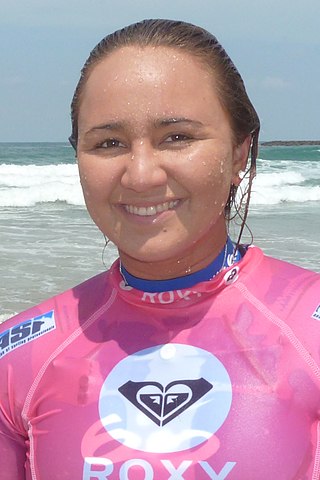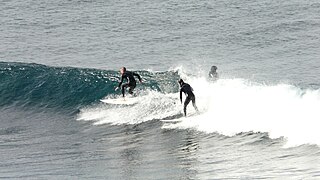
Layne Collette Beachley is an Australian former professional surfer from Manly, New South Wales. She won the World Championship seven times. Currently she is the chair of Surfing Australia.
Pauline Menczer is an Australian surfer. She was Women's World Champion for Professional Surfing in 1993.
Jessica Candice "Jessi" Miley-Dyer is a professional surfer from New South Wales, Australia. She currently resides in Sydney.

Stephanie Louise Gilmore is an Australian professional surfer and eight-time world champion on the Women's WSL World Tour.
Pam Burridge is an Australian surfer and one of the pioneers of women’s surfing in Australia.
The U.S. Open of Surfing is a week-long surfing competition held annually during the summer in Huntington Beach, California. Generally held on the south side of the Huntington Beach Pier, the U.S. Open is part of the qualification process for the World Surf League and is a WSL QS 10,000 event. It is the largest surfing competition in the world. It has been owned by IMG since 2000.
Piping Hot is an Australian surf and street clothing brand. It was established in 1975 by Fred Pyke and Rod Brooks in Torquay, Victoria.

Carissa Kainani Moore is a Hawaiian American Olympian, world champion surfer and activist. She was the first-ever winner of the Olympic Gold Medal in women's short board surfing in 2020. She was also the 2011, 2013, 2015, 2019 and 2021 World Surf League WSL Women's World Tour Champion. Moore is the first surfer in history to win a WSL world title and the Olympic title in the same year.

Sally Fitzgibbons is an Australian professional surfer on the Association of Surfing Professionals World Tour (2009–2013). In June 2019, she was ranked No. 1 in the world for women's surfing after winning the Rio Pro.

While not being urged to avoid competition, women had few opportunities to compete in sport in Australia until the 1880s. After that date, new sporting facilities were being built around the country and many new sport clubs were created.
While not being urged to avoid competition, women had few opportunities to compete in sport in Australia until the 1880s. After that date, new sporting facilities were being built around the country and many new sport clubs were created. For swimming, the rapid expansion of facilities took place during the 1880s and the 1890s. Compared to the past when the whole of the swimming community was made up of males, currently 55 percent of the Australian swimming membership is made up of women. Not only do females dominate swimming in the pool but there are more than 5,500 female coaches in the swimming world in Australian and over 2,000 female technical officials.

Australia is renowned as one of the world's premier surfing destinations. Surfing underpins an important part of the Australian coastal fabric. It forms part of a lifestyle in which millions participate and which millions more have an interest. Australian surfboard-makers have driven innovation in surfboard design and production since the mid-1960s. The country has launched corporate giants such as Billabong, Rip Curl and Quiksilver.
Surfing Australia is the governing body for the sport of surfing in Australia.

Tyler Wright is an Australian professional surfer on the WSL World Tour. She is a consecutive WSL Women's World Champion.
Barton Lynch is an Australian former professional surfer known for his competitive prowess and style. In 1988, he was crowned ASP World Tour Champion. He also won the 1991 Rip Curl Pro. In 1998, he was inducted into the Australian Surfing Hall of Fame, and in 2000, he was inducted into the Australian Sporting Hall of Fame. The video game Barton Lynch Pro Surfing is named after Lynch.

Women's surfing is thought to date back to the 17th century. One of the earliest records of women surfing is of princess Keleanohoana’api’api, also known as Kalea or the Maui Surf Riding Princess. It is rumored that Kalea was the trailblazer of surfing and could surf better than both men and women. A few centuries later in the mid-late 1800s, Thrum’s Hawaiian Annual reported that women in ancient Hawaii surfed in equal numbers and frequently better than men. Over the last 50 years, women's surfing has grown in popularity.
Australian Women's Health Women in Sport Awards were first awarded in 2011. The awards were established by the Australian Women's Health Magazine to recognise the achievements of Australian women in sport. The awards are the main awards for Australian women in sport and cover athletes, performances, teams, leaders and journalists. The awards are also known as "I Support Women in Sport Awards".

The 2019 World Surf League was the competition series hosted by the World Surf League, the global championship body for competitive surfing. The 2019 World Surf League consisted of the Championship Tour, the Qualifying Series, Big Wave Tour, Longboard Tour, Junior Tour, and other specialty tours and events such as the Vans Triple Crown.









